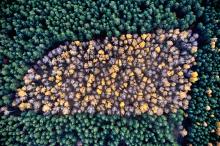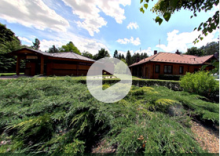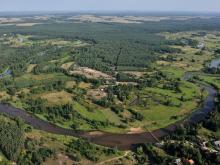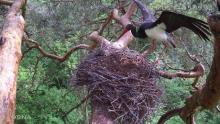 Asset Publisher
Asset Publisher
Polish forests
Poland is in the European lead, while concerning the area of all forests. They cover about 29,2 % of the country territory, and grow within the area of 9,1 million hectares. The overwhelming majority of the forests is state owned, of which almost 7,6 million hectares are managed by the State Forests National Forest Holding..
The number of Polish forest is still growing. The forestation rate of the country has increased from 21 % in 1945 to 29,2 % at the moment. Between 1995 and 2008, the forest area increased by 310 thousand ha. The basis for afforestation works is the "National Programme for Increasing the Forest Cover" (KPZL), assuming an increase of the forestation rate up to 30 % by 2020 and up to 33 % by 2050. Polish forests abound in flora, fauna and fungi. 65 % of the total number of animal species live there.
The forests grow in our country on poor soils, mainly because of the development of the agriculture in previous years. It influences the distribution of the types of the forest sites in Poland. Over 55 % of the forest areas is covered with coniferous forests. In other areas, there are forest sites, mainly the mixed ones. Their small part constitute alder and riparian forests – not more than 3 %.
In the years 1945 – 2011 the area of natural deciduous tree stands within the area of the State Forests National Forest Holding increased from 13 to 28,2 %.
Within the lowlands and uplands the most often occurring tee species is pine. It covers 64,3 % of the forest area of the State Forests National Forest Holding and 57,7 % of private and commune forests. In the mountains the predominant species is European spruce ( in the west) and European spruce with beech (in the east). Domination of pine is the result of carrying on sustainable forest management in the past. Once, the monocultures (crops or cultivations of one species) were the answer to the great demand of industry for wood. Such forests appeared to be quite fragile to climatic factors. They also were often the prey of pests' expansion.
In Polish forests, the share of other tree species, especially deciduous trees have been systematically increasing. The foresters have stepped aside from monocultures – that is why, they try to fit specific species of the forest stand to the natural stand, that would be proper for the given area. Thanks to that, in the years 1945 – 2011, the area of the deciduous tree stands within the lands of the State Forests National Forest Holding increased from 13 to 28,2 %. There occur more and more frequently the following tree species: oaks, ashes, maples, sycamore maples, elms, but also birches, beeches, alders, poplars, hornbeams, aspens, tilias and willows.
Our forests are the most often represented by the forest stands aged 40 to 80 years. The average age of the forest equals 60 years. More and more trees are of big size at the age over 80 years. Since the end of the Second World War, the forests' area has increased up to almost 1,85 million hectares.
Raport o stanie lasów w Polsce 2012
 Asset Publisher
Asset Publisher
Zostań Super Zakrętakiem w LP
Zostań Super Zakrętakiem w LP
Z radością informujemy, że leśnicy z RDLP w Łodzi i 19 Nadleśnictw dołączają do akcji „Zostań Super Zakrętakiem” realizowanej przez Stowarzyszenie „Łódzkie Hospicjum dla Dzieci – ŁUPKOWA”. Zakrętki zbierane do specjalnych pojemników firma recyklingowa przerabia na granulat i przekazuje do ponownego wykorzystania – a to realne pieniądze dla chorych dzieciaków!
Jedna osoba średnio jest w stanie zebrać kilka-kilkanaście kilogramów rocznie, ale jeśli połączymy siły to akcja ma szansę przynieść mnóstwo uśmiechu i radości podopiecznym placówki. Codziennie w całej Polsce do śmietników trafiają tony nakrętek z tysięcy gospodarstw domowych.
Hospicjum na Łupkowej zapewnia (m.in. z funduszy pozyskanych dzięki akcji) całodobową opiekę lekarską, pielęgniarską, rehabilitacyjną, socjalną, pedagogiczną, psychologiczną i duchową oraz sprzęt do oddychania.
Jak to działa?
- Zbieramy zakrętki i przynosimy je do pracy – RDLP czy biura Nadleśnictwa.
- Koordynator dostarczy je do siedziby RDLP, a RDLP do hospicjum.
- Wolontariusze przygotowują transport zbiorczy do firmy recyklingowej.
- Firma recyklingowa przerabia zakrętki na granulat i przekazuje do ponownego wykorzystania.
- Środki pozyskane z zakrętek wędrują na konto hospicjum i przeznaczane są na spełnienie marzeń podopiecznych.
- Dzieci zyskują bezcenną pomoc w realizacji ich pragnień i potrzeb – my otrzymujemy bezcenny uśmiech chorego dziecka.
- Środowisko dostaje bezcenną pomoc.
- Dzięki akcji pomagamy wdrażać nawyki rozważnego gospodarowania odpadami.
Do akcji zbierania nakrętek zdążyliśmy już przywyknąć. Z racji tego, że gromadzące je osoby nie ponoszą żadnych kosztów, ten sposób niesienia pomocy szybko zdobył popularność. Zbieranie i recykling nakrętek są bardziej opłacalne niż zbieranie plastikowych butelek i sprzedawanie ich do skupów. Butelki są trudniejsze w obróbce, zajmują więcej miejsca. Wymagają bardziej zaawansowanego, więc i kosztowniejszego sprzętu. Jednak tym, co łączy butelki i nakrętki, jest fakt, że każde gospodarstwo domowe codziennie pozbywa się i jednych, i drugich. Dlaczego więc nie pomóc innym, odkładając nakrętki, zamiast je wyrzucać? Moglibyśmy po prostu umieszczać taką nakrętkę w specjalnym pojemniku w ramach domowej segregacji śmieci. Jednak postępując tak, tracimy szansę na realną pomoc komuś, kto jej potrzebuje. Hospicjum, które odbiera nakrętki od kilkunastu czy kilkudziesięciu podmiotów, może zarobić na sprzedaży nakrętek bardzo wymierne pieniądze i przeznaczać je na konkretne cele!
Liczymy na to, że dzięki leśnikom spełnione zostanie niejedno dziecięce marzenie!


 fot. Paweł Fabijański
fot. Paweł Fabijański
 fot. Paweł Fabijański
fot. Paweł Fabijański
 fot. Paweł Fabijański
fot. Paweł Fabijański





